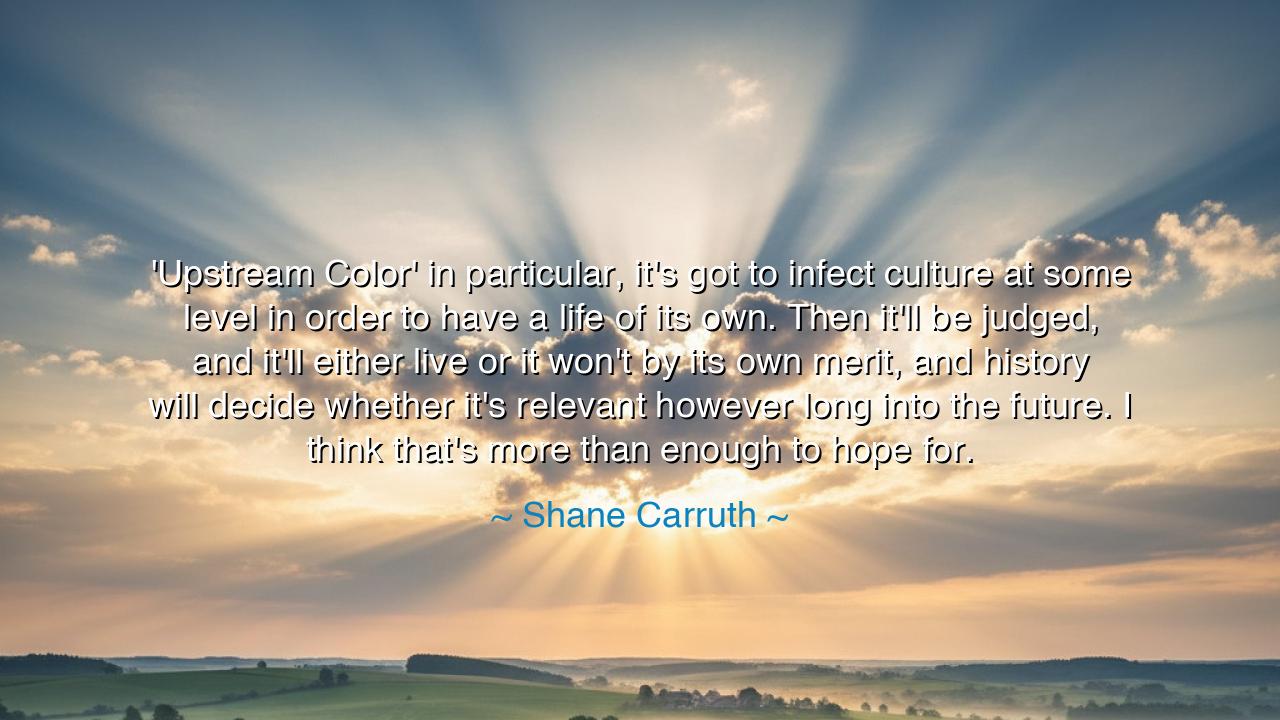
'Upstream Color' in particular, it's got to infect culture at
'Upstream Color' in particular, it's got to infect culture at some level in order to have a life of its own. Then it'll be judged, and it'll either live or it won't by its own merit, and history will decide whether it's relevant however long into the future. I think that's more than enough to hope for.






In the words of Shane Carruth, we find a profound reflection on the power of art and its place in culture. Carruth speaks to the idea that a piece of work, such as his film "Upstream Color", must first infect culture, must resonate deeply with people, before it can live and grow on its own. For art to truly become alive, it must be more than just a creation; it must engage with the world in a way that invites interpretation, discussion, and reflection. This engagement is what gives art its merit—it is in this interaction with society that it earns its place in history. Carruth’s perspective on the film’s legacy reveals the ancient truth that art does not belong to its creator alone but becomes part of the greater human experience, shaped by time and its impact on those who encounter it.
Consider the ancient poets and storytellers who sought to immortalize their work through the oral tradition. Homer, with his epics, did not merely create stories for himself; he crafted tales that would resonate with generations to come. His works, passed down through the ages, became more than just personal creations; they became cultural touchstones. Much like Carruth’s hope for "Upstream Color", these works lived and breathed through their impact on society. They were judged by the people who heard them, who took them to heart, and who passed them down to future generations. History, in its judgment, decided whether these stories would continue to be relevant and meaningful.
Carruth’s belief that his work will either live or fade based on its merit and its relevance echoes the teachings of ancient philosophers like Plato, who emphasized the timelessness of ideas that resonate deeply with the human soul. Plato believed that true knowledge and true art were those that touched upon the eternal truths—those that moved beyond the moment of creation to offer universal lessons. Just as Plato’s dialogues have lived on for millennia, art that connects with the soul of humanity, that infects culture in the way Carruth speaks of, will continue to live on by its own merit—not because it was forced to endure, but because it was chosen by the collective memory of society.
In the same way, consider the Renaissance painters, whose works were not just commissioned pieces but became part of a larger cultural movement. Leonardo da Vinci and Michelangelo did not just paint for the sake of painting, but to contribute to a larger cultural revolution that would change the way people viewed art, science, and life. Over time, their works became immortalized, not through the ego of their creators, but through the relevance they maintained in shaping the worldview of society. These works lived on, as Carruth hopes his film will, because they infected the culture and were judged by their impact, becoming timeless examples of human expression and thought.
Carruth’s words also suggest a certain humility—the understanding that art, once released into the world, takes on a life of its own. The creator can no longer control how it will be perceived or how it will evolve over time. This humility is the essence of the ancient notion of creative surrender, where the artist offers their work to the world with the understanding that it is no longer their own, but belongs to the collective experience of society. This acceptance that history will decide the work’s relevance is both freeing and deeply wise. The artist creates not for immediate recognition, but for the possibility that their work will find its way into the hearts and minds of others, ultimately earning its place in history.
The lesson here is clear: the value of art lies not in the recognition it receives at the moment of its creation, but in the legacy it leaves behind. Carruth teaches us that art is alive only when it touches something greater than the individual—when it connects with the culture it is born into and moves beyond its creator. This lesson extends beyond the realm of film and into all areas of life. Whether in our work, our relationships, or our passions, we must focus not on immediate validation, but on creating something of lasting value—something that will resonate and endure, regardless of the immediate outcome.
In our own lives, we must ask ourselves how we can contribute to the world in ways that will infect culture, that will inspire future generations to take up what we have created and make it their own. Let us not be concerned with fleeting recognition, but instead, let us invest in the timeless. In every action we take, in every piece of work we produce, let us focus on creating something of true merit, something that will outlast our time and speak to the heart of humanity, just as the stories, ideas, and works of the ancients have done for centuries. By doing so, we embrace the wisdom of Shane Carruth and the ancients, knowing that true significance comes not from the spotlight but from the lasting impact we leave on the world.






AAdministratorAdministrator
Welcome, honored guests. Please leave a comment, we will respond soon